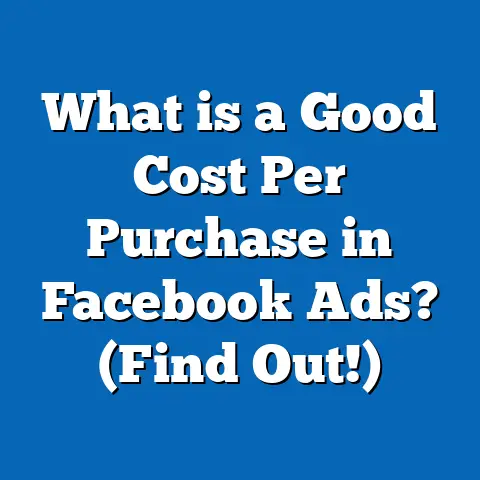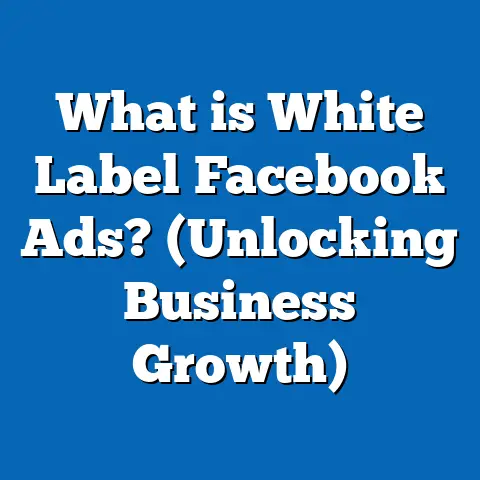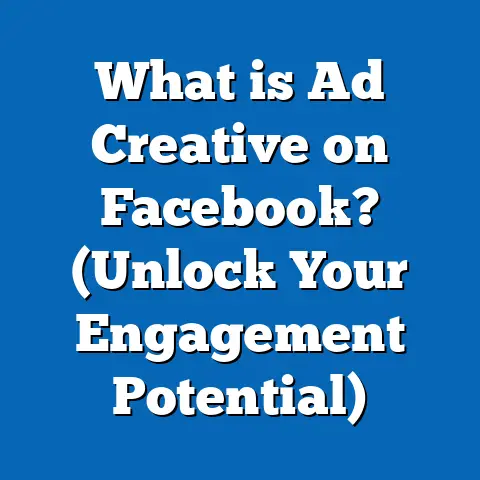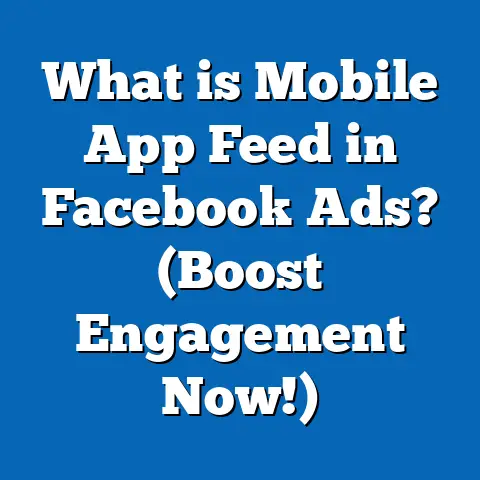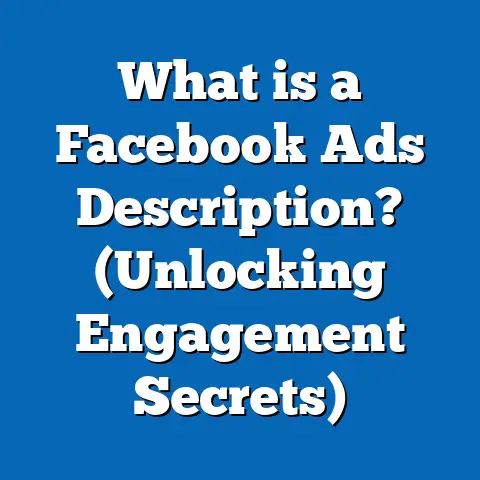What is Facebook Post Engagement Ad? (Unlocking Social Impact)
What is Facebook Post Engagement Ad? (Unlocking Social Impact)
Have you ever wondered why some Facebook posts seem to explode with likes, comments, and shares while others barely get noticed? What if you could harness this power to amplify your brand’s message, boost visibility, and create meaningful connections with your audience? This is where Facebook Post Engagement Ads come into play—a potent tool in the marketer’s arsenal designed to maximize social interaction.
Why Focus on Engagement?
In the digital marketing landscape, engagement is a vital indicator of how well your content resonates with your audience. When users interact with your posts—whether by reacting, commenting, or sharing—it creates a ripple effect that amplifies your brand’s visibility and credibility. According to a 2023 study by Sprout Social, posts that generate more than 100 interactions within the first hour are 70% more likely to appear in users’ feeds organically.
Understanding Facebook Post Engagement Ads
What Are Facebook Post Engagement Ads?
Facebook Post Engagement Ads represent a campaign objective within Facebook Ads Manager that focuses on increasing interactions on your posts. Unlike traffic or conversion campaigns which prioritize clicks or purchases, engagement ads are about encouraging social actions—likes, comments, shares, video views, and event responses.
These ads help marketers:
- Boost the visibility of their posts.
- Build social proof.
- Increase interaction rates.
- Facilitate community conversations.
Types of Engagement Facebook Tracks
Facebook measures engagement through several key actions:
- Likes and Reactions: Simple indicators of approval or emotional response (love, wow, sad, angry).
- Comments: Reflect active user participation.
- Shares: Extend content beyond your immediate audience.
- Video Views: Track how many users watched your videos (with varying durations like 3 seconds, 10 seconds).
- Event Responses: Specific to event-related posts where users RSVP.
Importance of Engagement for the Facebook Algorithm
Facebook’s algorithm prioritizes content that generates meaningful interactions. When a post receives high engagement, it signals to the algorithm that the content is valuable and relevant. This results in increased organic distribution beyond just paid reach.
According to Facebook’s own data (2023), posts with engagement rates above 6% can see up to 40% higher organic reach compared to those with rates below 2%.
Why Use Facebook Post Engagement Ads?
Benefits of Post Engagement Ads
- Enhanced Organic Reach
Engagement ads help increase your post’s visibility not only through paid promotion but also organically. The more people like or comment on your post, the more it shows up in friends’ feeds of those who engaged.
- Builds Social Proof
Social proof is a psychological phenomenon where people assume the actions of others reflect correct behavior. A post with thousands of likes and comments appears trustworthy and credible.
- Cost-Effective Marketing
Compared to conversion-focused campaigns, engagement ads typically have lower Cost Per Engagement (CPE). According to WordStream (2024), average CPE on Facebook ranges from $0.10 to $0.50 depending on industry and ad quality.
- Community Building
Higher engagement fosters a sense of community. Responding to comments and encouraging discussions can deepen brand loyalty.
- Valuable Customer Insights
Comments provide direct feedback about customer preferences and opinions which can guide product development and marketing messaging.
Data-Backed Insights
- Businesses that integrated post engagement ads into their strategy saw a 37% increase in overall page reach within one month (Facebook Business Insights, 2023).
- Posts with over 1,000 engagements are 5 times more likely to lead to website clicks compared to posts with few interactions (HubSpot, 2023).
- According to Social Media Examiner’s 2024 report, brands using engagement ads reported an average engagement rate increase of 25% compared to organic-only efforts.
How Do Facebook Post Engagement Ads Work?
The Algorithmic Optimization Process
When you select “Engagement” as your campaign objective in Facebook Ads Manager, the algorithm optimizes ad delivery to people most likely to interact with your content based on behavioral signals such as:
- Past post likes
- Commenting habits
- Sharing frequency
- Video watch time
Facebook’s machine learning continually tests different audience segments during the ad run and reallocates budget towards those generating the highest engagement.
Targeting Options
Facebook provides powerful targeting options that allow you to:
- Focus on core demographics: age, gender, location
- Narrow down interests aligned with your niche
- Target behaviors such as frequent engagers or online shoppers
- Use Custom Audiences based on website visitors or email lists
- Create Lookalike Audiences similar to people who have engaged with your page or posts
These options ensure your post engagement ad reaches people most likely to interact.
Types of Posts Suitable for Engagement Ads
While any post can be promoted for engagement, some formats perform better:
- Questions or Polls: Naturally encourage comments.
- Contests or Giveaways: Drive shares and participation.
- Videos: Higher chances of views and reactions.
- User-generated Content: Builds authenticity.
- Behind-the-scenes or Storytelling Posts: Connect emotionally.
Step-by-Step Guide to Creating a Facebook Post Engagement Ad
Step 1: Select a Post with High Potential
Choose content that either already has some organic engagement or naturally invites interaction. For example:
- A question post: “What’s your favorite summer workout?”
- A poll: “Which new product should we launch next? A or B?”
- A compelling video demonstrating product use.
Step 2: Access Facebook Ads Manager
Go to Facebook Ads Manager and create a new campaign selecting Engagement as your objective.
Step 3: Define Your Audience
Use demographic filters combined with interest-based targeting. For example, if promoting a fitness post:
- Location: Within a city or specific region
- Age: 18–45
- Interests: Fitness, health clubs, running
Consider layering behaviors such as “People who frequently engage with fitness content.”
Step 4: Set Your Budget and Schedule
Start small with $5–$10/day budget to test performance.
Choose ad scheduling during peak times when your audience is most active (e.g., evenings or weekends).
Step 5: Optimize Your Ad Creative
Ensure your post creative is clear and engaging:
- Use bright visuals or videos.
- Add compelling captions.
- Include CTA like “Share if you agree!” or “Comment your thoughts!”
Step 6: Launch and Monitor
Track key metrics such as:
- Likes/Reactions
- Comments
- Shares
- Video Views (if applicable)
- Cost per Engagement (CPE)
Use Facebook’s breakdown reports to analyze performance by demographics or placements.
Step 7: Optimize Based on Results
If certain audiences respond better, increase budget allocation there.
Try different creative variations for low-performing ads.
Advanced Tactics for Maximizing Facebook Post Engagement Ads
1. Utilize Lookalike Audiences for Wider Reach
Create Lookalike Audiences based on users who already engage with your page or posts. This helps find new users similar in behavior and interests without manual targeting guesswork.
For example:
- Upload a list of people who commented or shared.
- Create a Lookalike Audience at 1% similarity for precise targeting.
- Expand gradually up to 5% similarity for broader reach.
2. Retarget Engaged Users for Deeper Conversions
People who engage once are more likely to convert later. Use Custom Audiences to retarget:
- Users who commented on posts.
- Video viewers who watched over 50%.
- People who clicked but didn’t take further action.
This layered approach nurtures prospects through the funnel.
3. Test Interactive Content Formats
Facebook offers interactive tools like polls in Stories or interactive video ads.
Polls generate direct feedback while interactive videos boost average watch time and comments.
Example: A restaurant could run a poll asking “Which new dish should we add?” generating buzz and feedback simultaneously.
4. Use Emotionally Resonant Storytelling
Stories that evoke emotions tend to drive more comments and shares.
Use real customer testimonials or behind-the-scenes content showing your brand’s human side.
Example: A nonprofit sharing impact stories paired with calls-to-action can generate heartfelt engagement and donations.
Measuring Success: Key Metrics for Post Engagement Ads
Primary Metrics
| Metric | What It Measures | Why It Matters |
|---|---|---|
| Likes & Reactions | Number of positive interactions | Indicates approval & emotional response |
| Comments | Number of user responses | Shows active participation & conversation |
| Shares | Number of times post is shared | Extends organic reach & credibility |
| Video Views | Number of video watches (3s/10s+) | Measures video content effectiveness |
| Cost Per Engagement (CPE) | Average spend per interaction | Evaluates cost-efficiency of ads |
Secondary Metrics
- Engagement Rate: Total engagements divided by impressions; indicates content resonance.
- Reach: Number of unique users who saw the post.
- Frequency: Average number of times an individual sees the ad; too high frequency may cause ad fatigue.
Real World Examples and Case Studies
Case Study 1: E-commerce Brand Boosts Sales Through Engagement Ads
A skincare brand used post engagement ads featuring customer testimonials combined with educational videos explaining product benefits.
- Targeting young women aged 18–35 interested in beauty products.
- Ran ads for four weeks with an average daily budget of $20.
Results:
- Post engagement increased by 65%.
- Organic reach increased by 50%.
- Website traffic from Facebook increased by 30%.
- Direct sales attributed to retargeting engaged users rose by 15%.
Case Study 2: Local Restaurant Drives Foot Traffic Using Polls
A local restaurant ran a series of poll posts asking users to vote on new menu items using Facebook Post Engagement Ads targeted at nearby residents aged 25–50.
Results:
- Average engagement rate per post reached 12%, significantly higher than industry average of 6%.
- Foot traffic increased by 18% during campaign period.
- A sense of community built around the brand through ongoing conversations in comments.
Comparing Facebook Post Engagement Ads With Other Platforms
| Feature | Facebook Post Engagement Ads | Instagram Engagement Ads | Twitter Promoted Tweets |
|---|---|---|---|
| Audience Targeting | Highly granular via Facebook data | Same as Facebook (due to integration) | Less granular than FB/IG |
| Types of Engagement | Likes, comments, shares, video views | Likes, comments, shares, story replies | Likes, retweets, replies |
| Algorithm Influence | Strong effect on organic reach | Strong effect on feed ranking | Limited effect compared to FB/IG |
| Visual Emphasis | Flexible (images/videos/text) | Heavy focus on visuals & Stories | Text-heavy with media support |
| Cost Efficiency | Moderate to low CPE | Slightly higher CPM | Variable CPM depending on campaign |
Instagram benefits from visual appeal but often costs more per engagement. Twitter’s real-time conversations provide different dynamics but less organic amplification from paid engagement ads.
Common Challenges and How to Overcome Them
Challenge #1: Low Initial Engagement Despite Paid Promotion
Solutions:
- Improve creative quality: Use high-resolution images/videos that capture attention.
- Craft compelling captions asking questions or encouraging interaction.
- Refine targeting by narrowing interests or demographics.
- Test different types of posts such as videos vs static images.
Challenge #2: Handling Negative Comments Publicly
Solutions:
- Develop a clear comment moderation policy.
- Respond promptly but professionally to negative feedback.
- Use negative comments constructively for improvement.
Challenge #3: Ad Fatigue Over Time
Solutions:
- Rotate creative regularly every 7–10 days.
- Adjust audience targeting frequently.
- Use frequency caps to avoid showing ads too often.
Latest Trends in Facebook Post Engagement Ads (2024)
AI-Powered Creative Testing
Facebook now offers AI-driven tools that automatically test multiple ad creatives simultaneously, optimizing for highest engagement in real-time without manual intervention.
Short-form Video Dominance
With the rise of Reels and Stories formats across social platforms including Facebook, short-form video content is outperforming other formats in engagement rates by up to 30%.
Integration With E-commerce Features
Facebook Shops integrated with engagement ads allow direct purchases from product-tagged posts increasing ROI from social interactions.
Augmented Reality (AR) Experiences
AR filters and interactive effects embedded in ads provide immersive experiences that drive higher engagement levels—up to double traditional ad formats according to Facebook AR Insights (2024).
Practical Tips for Marketers and Business Owners
- Focus on Value-Oriented Content
Balance promotional posts with content that educates or entertains your audience.
- Use Data Analytics Regularly
Analyze which posts generate the highest engagement and why; replicate successful tactics.
- Engage Back
Respond promptly to comments—human interaction fosters loyalty.
- Combine With Other Funnel Campaigns
Use engagement campaigns as a top-funnel effort complemented by conversion campaigns retargeting engaged users.
- Leverage User Generated Content
Encourage followers to create and share content related to your brand; boost this content via engagement ads.
Summary & Next Steps
Facebook Post Engagement Ads offer an essential method for brands looking to increase social interaction, build community trust, and improve organic reach on the platform. By understanding how these ads work, leveraging advanced targeting strategies, continually optimizing creative elements, and staying abreast of evolving trends like AI tools and short-form video dominance, marketers can unlock powerful social impact opportunities.
Next Steps:
- Audit your current Facebook posts—identify those with natural engagement potential.
- Create an initial post engagement campaign focused on high-performing content.
- Monitor key metrics closely; adjust targeting and creative based on data insights.
- Experiment with interactive formats like polls or live videos.
- Integrate engagement data into broader marketing funnels for conversions.
This extensive guide should empower you with both foundational knowledge and tactical expertise needed to successfully implement Facebook Post Engagement Ads for meaningful social impact and business growth.

